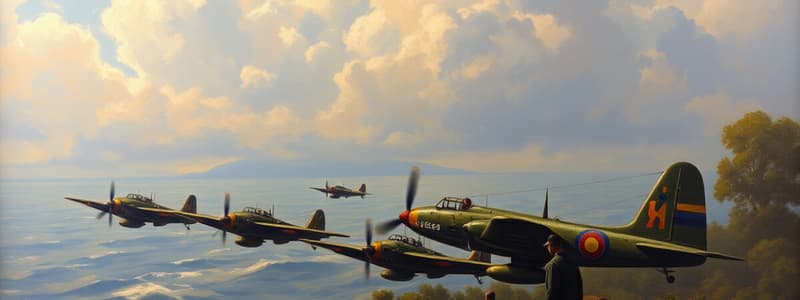Podcast
Questions and Answers
The World War II strategy used by the US for attacking Japan was called?
The World War II strategy used by the US for attacking Japan was called?
- Nimitz strategy
- Island hopping (correct)
- Kamikaze attacks
- MacArthur strategy
During World War II, who was the commander-in-chief of the Pacific fleet?
During World War II, who was the commander-in-chief of the Pacific fleet?
- Chester Nimitz (correct)
- Dwight D. Eisenhower
- George S. Patton
- Douglas MacArthur
Which is a result of island hopping?
Which is a result of island hopping?
- The Axis powers gained additional power in the Pacific.
- Islands were bombed from the air without the use of land troops.
- The end of the war was faster and fewer lives were lost. (correct)
- Islands that were once held by the US are now held by Japan.
During World War II, which battle denied the Japanese the opportunity to attack Australia?
During World War II, which battle denied the Japanese the opportunity to attack Australia?
Which of the following losses changed Japan's plan of advancing and taking islands in the Pacific?
Which of the following losses changed Japan's plan of advancing and taking islands in the Pacific?
Which of the following arguments decided the debate over using the atomic bomb against Japan in 1945?
Which of the following arguments decided the debate over using the atomic bomb against Japan in 1945?
Which Allied nation dropped the atomic bomb on Japan in 1945?
Which Allied nation dropped the atomic bomb on Japan in 1945?
During World War II, which battle was the first significant US victory in the Pacific?
During World War II, which battle was the first significant US victory in the Pacific?
As a result of Japan's increasing use of suicide attacks in 1945, Allied leaders began?
As a result of Japan's increasing use of suicide attacks in 1945, Allied leaders began?
What made Allied leaders worry about the cost of invading the Japanese mainland?
What made Allied leaders worry about the cost of invading the Japanese mainland?
Study Notes
U.S. Strategy in the Pacific
- The strategic approach employed by the United States during World War II to combat Japan is known as island hopping.
- Chester Nimitz served as the commander-in-chief of the Pacific fleet during the conflict.
Results of Island Hopping
- Island-hopping contributed to a quicker conclusion of the war and resulted in fewer casualties compared to traditional warfare.
Key Battles
- The Battle of the Coral Sea hindered Japanese plans to attack Australia.
- Japan's defeat at the Battle of Midway significantly altered its strategy by eliminating key aircraft carriers.
Atomic Bomb Decision
- The primary rationale for deploying the atomic bomb against Japan in 1945 was that it would accelerate the end of the war and reduce casualties among Allied troops.
Historical Context of the Atomic Bomb
- The United States was the Allied nation responsible for dropping atomic bombs on Japan.
Significant U.S. Victories
- The Battle of Midway marked the first substantial victory for U.S. forces in the Pacific theater.
Response to Japanese Tactics
- In response to Japan's increased use of suicide attacks, Allied leaders considered alternative strategies rather than directly invading the Japanese mainland.
Concerns about Invasion Costs
- The threat of kamikaze fighters raised significant concerns among Allied leaders regarding the potential high costs associated with invading Japan.
Studying That Suits You
Use AI to generate personalized quizzes and flashcards to suit your learning preferences.
Description
Test your knowledge on key strategies and commanders of the Pacific theater during World War II with these flashcards. This quiz covers important concepts like the MacArthur strategy and figures such as Chester Nimitz. Perfect for students of U.S. history learning about this pivotal time in the war.




